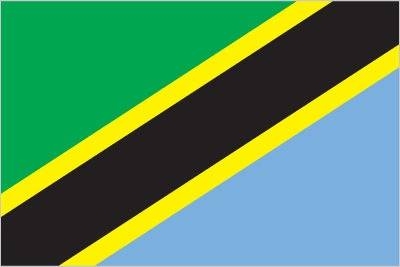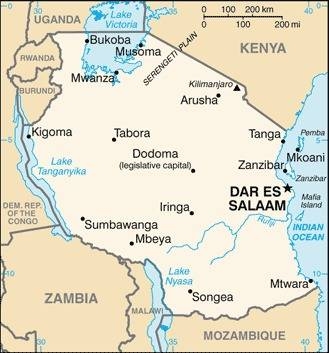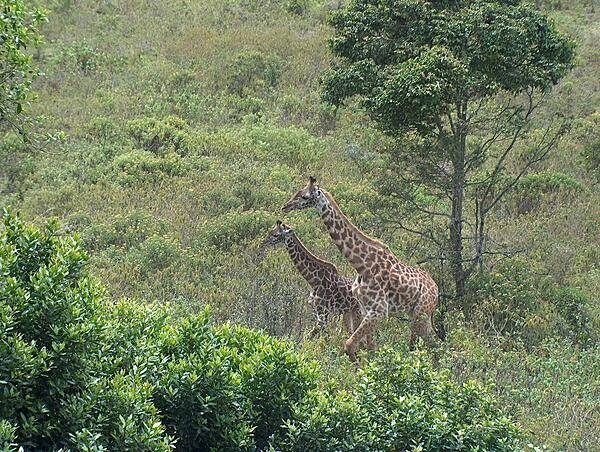225 Tanzania

Divided diagonally by a yellow-edged black band from the lower hoist-side corner. The upper triangle (hoist side) is green and the lower triangle is blue. The banner combines colors found on the flags of Tanganyika and Zanzibar. Green represents the natural vegetation of the country, gold its rich mineral deposits, black the native Swahili people, and blue the country’s many lakes and rivers, as well as the Indian Ocean.
Flag courtesy of the CIA World Factbook

Map courtesy of the CIA World Factbook

Giraffes at Arusha National Park.
Photo courtesy of the CIA World Factbook
Government
According to Britannica, the Interim Constitution of 1965 established the United Republic of Tanzania through the merger of Tanganyika and Zanzibar, until then separate and independent countries. A permanent constitution for the United Republic was approved in 1977 and amended in 1984 to include a bill of rights.
Zanzibar has a separate constitution, approved in 1979 and amended in 1985. The executive branch is composed of a president, elected by popular vote to a maximum of two five-year terms, and a cabinet called the Supreme Revolutionary Council. Zanzibar’s parliament, the House of Representatives, is made up of elected and appointed members. These political bodies deal with matters internal to Zanzibar. Since the union with Tanganyika, some segments of Zanzibari society have occasionally demanded greater autonomy from the mainland.
The president of the United Republic is the head of state and commander in chief of the armed forces. The cabinet of ministers is advisory to the president. Prior to 1995 it included two vice presidents: the prime minister, who is appointed by the president and acts as the leader of the cabinet, and the president of Zanzibar. Since then an amendment to the constitution, which was approved in 1994 and took effect after the 1995 general election, has rescinded the stipulation that called for the president of Zanzibar to serve as a vice president.
According to the 1984 constitutional amendments, most members of the unicameral National Assembly are directly elected. Many seats also are allocated to ex-officio, nominated, and indirectly elected members, including those seats reserved for women, representatives of mass organizations, and the president’s nominees. The National Assembly has a term of five years but can be dissolved by the president before this term expires.
For administrative purposes, mainland Tanzania is divided into regions. Each region is administered by a commissioner who is appointed by the central government. At district, division, and ward levels, there are popularly elected councils with appointed executive officers.
Tanzania’s judiciary is appointed by the president in consultation with the chief justice. A network of primary and district courts has been established throughout the country; right of appeal for the district courts is to the high court. English, Islamic, and customary laws have been absorbed into the legal system. In Zanzibar the highest judicial authority is the Supreme Council. Muslim courts deal with marriage, divorce, and inheritance.
Directorate of Civil Aviation (DCA)
The Directorate of Civil Aviation (DCA) came to an end in March 1999 following the establishment of Tanzania Civil Aviation Authority (TCAA) as an Executive Agency of the Government. In September 1998, Engineer Margaret T. Munyagi was appointed as the Director General to lead the Agency. Tanzania introduced two Government Executive Agencies, the Tanzania Airport Authority (TAA) in 1999 and the Tanzania Government Flight Agency (TGFA) in 2002. TAA is mandated to manage all public airports while TGFA provides air services to VIP’s and government officials. Another significant development of administration of civil aviation sub-sector in Tanzania and East African Community was the establishment of the East African Community Civil Aviation safety and Security Oversight Agency (CASSOA). The Agency was established in June 2007 and its first Executive Director of the Agency was a Tanzanian Mr Mtesigwa O. Maugo. The Agency is a technical institution of the Community responsible for strengthening civil aviation oversight institutional framework in the region. Its responsibilities among others include promoting the safe, secure and efficient use and development of civil aviation within and outside the Partner States; assisting the Partner States in meeting their safety and security oversight obligations and responsibilities under the Chicago Convention and its Annexes; and providing the Partner States with an appropriate forum and structure to discuss plan and implement common measures required for achieving the safe and orderly development of international civil aviation through the implementation of international standards and recommended practices relating to the safety and security of civil aviation.
Airspace
SkyVector – Google Maps – ADS-B Exchange
ICAO countries publish an Aeronautical Information Publication (AIP). This document is divided into three parts: General (GEN), En Route (ENR) and Aerodromes (AD). ENR 1.4 details the types of airspace classes they chose to adopt from classes A through G.
Drone Regulations
The Civil Aviation (Remotely Piloted Aircraft Systems) Regulations, 2018
The Civil Aviation (Remotely Piloted Aircraft Systems) (Amendment) Regulations, 2020
Advanced Air Mobility (AAM) Regulations & Policies
None found by the author.
However, should you, the reader, happen to stumble across something to the contrary, please email the author at FISHE5CA@erau.edu and you may be mentioned in the ACKNOWLEDGEMENTS section of this book by way of thanks for contributing to this free eBook!
Advanced Air Mobility (AAM) News
2025
Video courtesy of Advanced Air Mobility Institute from the January 2025 Global AAM Forum. Complete session for Day 2 of this Forum is available on the Advanced Air Mobility Institute YouTube Channel
Short Essay Questions
Scenario-Based Question
You have been hired by a Drone Startup Company. Your boss has immediately assigned this job to you.
They need you to prepare a one-page memo detailing the legalities of using a drone to film in Arusha National Park.
They need you to mention any national laws and local ordinances.
They specifically want to know what airspace (insert pictures) you will be operating in and whether or not you need an airspace authorization.
Does it matter whether or not you are a citizen of the country?
Lastly, there is a bonus for you if, as you scroll through this chapter, you find any typos or broken links!
Short Essay Questions
- What are the drone categories?
- How is registration addressed?
- How is remote ID addressed?
- What are the model aircraft rules?
- What are the commercial drone rules?
- Are there waivers or exemptions to the rules? If so, for what?
- Would you share a link to an interactive airspace map?
- How is BVLOS addressed?
- How can you fly drones at night?
- How can you fly drones over people?
- Where do you find drone NOTAMs?
- What are the rules for drone maintenance?
- What are the rules for an SMS program?
- What are some unique rules not mentioned above?
- What are the C-UAS rules?
- What are the AAM rules?

